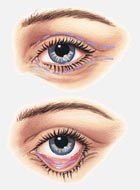| Surgery of the Eyelids(Blepharoplasty)
Your eyes are often the first feature that people notice when they meet you. If loose skin caused by aging or sun damage has caused the skin around your eyes to become wrinkled, puffy, or droopy, you may be perceived as tired, angry, or older than you really are. The skin around the eyes and eyelids is very delicate and shows signs of aging much sooner than skin in other areas of the face. Blepharoplasty, or eyelid plastic surgery, can help patients to correct drooping upper eyelids; under-eye bags can also be reduced and firmed up with eyelid plastic surgery. With smoother, younger-looking skin, your eyes will brighten up your whole face. The incisions for upper eyelid plastic surgery are easily hidden along the naturally occurring creases in the upper eyelid. If your procedure will involve the removal of skin and tissue below the eyes, Dr. Pryor will place the incisions just beneath the lower eyelashes. After making the incisions, Dr. Pryor will contour the underlying muscle and tissue before closing the incision with tiny sutures, leaving the skin smooth and tight. Eyelid plastic surgery is typically performed at our Scottsdale practice as outpatient surgery; depending on the extent of surgery required, the procedure usually takes 30 minutes to two hours and can be performed under light sedation. To ensure a complete approach to facial rejuvenation, blepharoplasty is sometimes combined with other facial surgery procedures such as a brow lift. |
Every year, one hundred thousand men and women choose blepharoplasty to improve the way they look. Droopy eyelids can make you look older and can also impair vision. Blepharop lasty corrects these problems and also removes puffiness and bags under the eyes that make you look worn and tired. This procedure cannot alter dark circles, fine lines and wrinkles around the eyes, nor can it change sagging eyebrows. Though blepharoplasty is often performed as a single procedure, your surgeon may also recommend a browlift, facelift, or skin resurfacing to achieve the best results. If you are wondering how blepharoplasty can change the way you look, you need to know how eyelid surgery is performed and what you can expect from this procedure. This pamphlet can address many common questions and provide you the information to begin considering blepharoplasty. Successful facial plastic surgery is a result of good rapport between patient and surgeon. Trust, based on realistic expectations and exacting medical expertise, develops in the consulting stages before surgery. Your surgeon can answer specific questions about your specific needs. Is Blepharoplasty For You? People with circulatory, ophthalmological, or serious me |
 |
| |||
dical conditions must rely on the diagnostic skills of their own personal specialists to determine whether blepharoplasty is an option to consider. Consultation with the facial plastic surgeon can help you decide whether any additional, complementary surgery would increase the success of the surgery. Your surgeon might recommend planning a simultaneous forehead lift to correct a drooping brow and smooth the forehead, or skin resurfacing to remove the fine line wrinkling in the eye area. Making The Decision For Blepharoplasty During the pre-surgical consultation, you will be examined or asked to answer queries concerning vision, tear production, use of lenses, and your desires for surgery. Your surgeon will explain what you can expect from blepharoplasty and take a complete medical history. Factors to be weighed include age, skin type, ethnic background, and degree of vision obstruction. Furthermore, you can expect an open and honest exchange between you and your surgeon, which will establish the basis for a successful outcome. After a mutual decision is made by both you and your surgeon, the technique indicated for your individual surgery will be discussed. The type of anesthesia, the surgical facility, any supportive surgery, and the risks and costs inherent in the procedure will be outlined. Understanding The Surgery
What To Expect After The Surgery Immediately after the surgery has been completed, your surgeon may apply tiny sterile bandages. This is not done for transconjunctival blepharoplasty. It is not crucial that the eyes be covered. However, an ointment to prevent dryness of the eye area may be used. A certain degree of swelling and bruising is normal. Cold compresses, as well as head elevation when lying down, will enhance healing and relieve discomfort. Your surgeon will prescribe medication for discomfort. For a week and a half following blepharoplasty, you will clean the eye area (the eyes may feel sticky, dry, and itchy). Eyedrops may be recommended. Your surgeon will also list activities and environments to avoid in the weeks immediately following surgery. Permanent stitches will be removed in three to five days after surgery. Self-absorbing stitches will dissolve on their own. Facial plastic surgery makes it possible to correct many facial flaws and signs of premature aging that can undermine self-confidence. By changing how you look, facial plastic surgery can help change how you feel about yourself. Insurance does not generally cover surgery that is done purely for cosmetic reasons. Surgery to correct or improve vision or surgery for eye deformity or injury may be reimbursable in whole or in part. It is the patient's responsibility to check with the insurance carrier for information on the degree of coverage. Preoperative packetPostoperative care instructions | |||||



